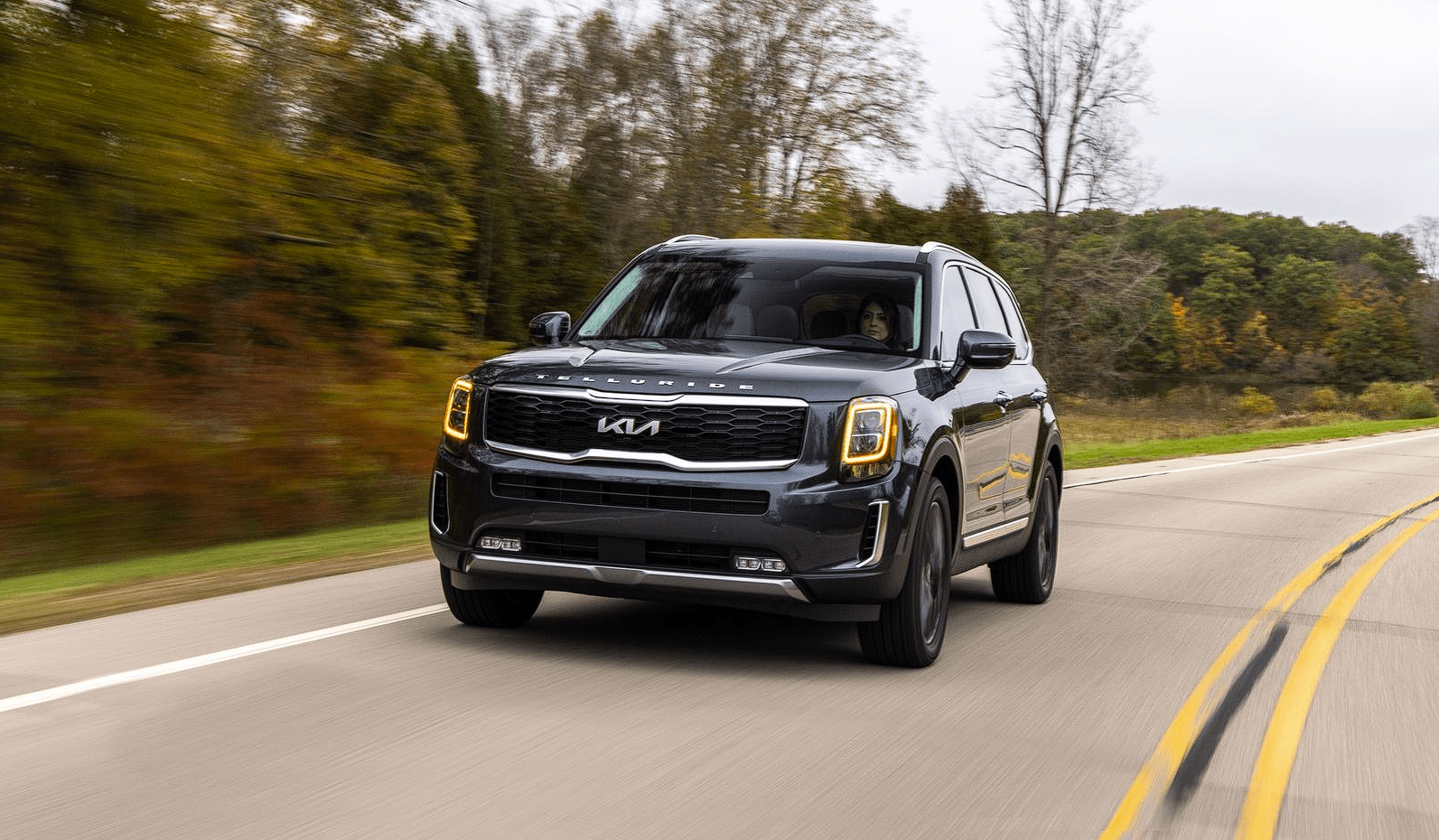Kia Telluride 2022 Child Restraint System (CRS)
In terms of family-friendly car safety, the 2022 Kia Telluride Child Restraint System (CRS) stands out as a stronghold of protection. This shows that Kia is dedicated to keeping our children safe, who are our most valuable goods. This carefully thought out and thoroughly tested method shows how important child safety is on the Telluride. It makes sure that the youngest passengers are safe and snug on every trip. The Telluride works with many types of child restraint systems (CRS), such as rear-facing infant seats, convertible seats, and booster seats. It gives parents and caregivers a complete system for child passenger safety, helping them follow important weight, height, and fitting rules. In this in-depth look, we explore the complicated world of the 2022 Kia Telluride Child Restraint System, revealing its many features, how to install it, and the peace of mind it gives families, making every drive in this great midsize SUV safety-focused and enjoyable.
2023 Kia Telluride Specs, Price, Features and Mileage (Brochure)
Child Restraint System (CRS)
Infants and younger children must be restrained in an appropriate rear-facing or forward-facing Child Restraint System (CRS) that has first been properly secured to the rear seat of the vehicle. Please refer to your state or federal laws for child seating requirements in the operation of a motor vehicle.
Children are always in the rear
Children under age 13 must always ride in the rear seats and must always be properly restrained to minimize the risk of injury in an accident, sudden stop or sudden manoeuvre.
WARNING
Restraint Location
Never install a child or infant seat on the front passenger’s seat. A child riding in the front passenger seat can be forcefully struck by an inflating airbag and seriously injured.
WARNING
Hot Child Restraint
A Child Restraint System can become very hot if it is left in a closed vehicle on a sunny day. Be sure to check the seat cover, buckles and latches before placing a child in the restraint system.
According to accident statistics, children are safer when properly restrained in the rear seats than in the front seat. Even with air bags, children can be seriously injured or killed. Children too large for a child restraint must use the seat belts provided.
All 50 states have child restraint laws which require children to travel in approved child restraint devices. The laws governing the age or height/weight restrictions at which seat belts can be used instead of child restraints differs among states, so you should be aware of the specific requirements in your state, and where you are travelling.
The CRS must be properly placed and installed in the rear seat. You must use a commercially available CRS that meets the requirements of the Federal Motor Vehicle Safety Standards (FMVSS).
A CRS is generally designed to be secured in a vehicle seat by lap belt portion of a lap/shoulder belt, or by a LATCH system in the rear seats of the vehicle.
Child Restraint System (CRS)
Infants and younger children must be restrained in an appropriate rear-facing or forward-facing CRS that has first been properly secured to the rear seat of the vehicle. Read and comply with the instructions for installation and use provided by the manufacturer of the CRS.
WARNING
Child Restraint Installation
An improperly secured child restraint can increase the risk of serious injury or death in an accident. Always take the following precautions when using a Child Restraint System:
- Always follow the Child Restraint System manufacturer’s instructions for installation and use. Always properly restrain your child in the child restraint.
- If the vehicle head restraint prevents proper installation of a child seat (as described in the Child Restraint System manual), the head restraint of the respective seating position shall be readjusted or entirely removed.
- Do not use an infant carrier or a child safety seat that “hooks” over a seatback as it may not provide adequate protection in an accident.
- Be especially careful when installing a child restraint on the centre seating position in the second row as it is narrower- er than the outboard positions. A wide child restraint installed on the centre seat may cover the safety belt buckles for the other seating positions. Do not allow someone to ride in a seating position where the safety belt buckle is covered by a child restraint.
- A child restraint in the centre seating position may also contact or push up against the safety belt buckles, which can damage the buckles and make them unusable or unsafe. Always check that the child restraint does not contact any of the safety belt buckles. Check the placement of the child restraint regularly to make sure that it has not shifted and come into contact with any of the safety belt buckles.
NOTICE
After an accident, have a Kia dealer check the Child Restraint System, seat belts, tether anchors and lower anchors.
Selecting a CRS
When selecting a CRS for your child, always:
- Make sure the CRS has a label certifying that it meets applicable Federal Motor Vehicle Safety Standards (FMVSS 213).
- Select a child restraint based on your child’s height and weight. The required label or the instructions for use typically provide this information.
- Select a child restraint that fits the vehicle seating position where it will be used.
- Read and comply with the warnings and instructions for installation and use provided with the CRS.
WARNING
Holding Children
Never hold a child in your arms or lap when riding in a vehicle. The violent forces created during a crash will tear the child from your arms and throw the child against the car’s interior. Always use a Child Restraint System that is appropriate for your child’s height and weight.
WARNING
Unattended Children
Never leave children unattended in a vehicle. The car can heat up very quickly, resulting in injuries to the child in the vehicle.
WARNING
Seat Belt Use
Do not use one seat belt for two occupants at the same time. This will eliminate any safety benefits provided by the seat belt to the occupants.
CRS types
There are three main types of CRS: rear-facing seats, forward-facing seats, and booster seats. They are classified according to the child’s age, height and weight.
Rear-facing child seats
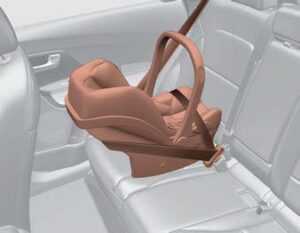
A rear-facing child seat provides restraint with the seating surface against the back of the child. The harness system holds the child in place, and in an accident, acts to keep the child positioned in the seat and reduces the stress to the neck and spinal cord.
All children under age one must always ride in a rear-facing infant child restraint.
Convertible and 3-in-1 child seats typically have higher height and weight limits for the rear-facing position, allowing you to keep your child rear-facing for a longer period of time.
Continue to use a rear-facing child seat for as long as your child will fit within the height and weight limits allowed by the child seat manufacturer. It’s the best way to keep them safe. Once your child has outgrown the rear-facing child restraint, your child is ready for a forward-facing child restraint with a harness.
Forward-facing child restraints
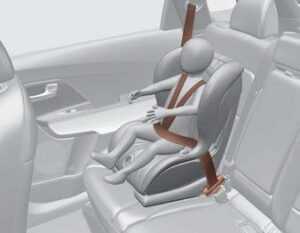
A forward-facing child seat provides restraint for the child’s body with a harness. Keep children in a forward-facing child seat with a harness until they reach the top height or weight limit allowed by your child restraint manufacturer.
Once your child outgrows the forward-facing child restraint, your child is ready for a booster seat.
Booster seats
A booster seat is a restraint designed to improve the fit of the vehicle’s seat belt system. A booster seat positions the seat belt so that it fits properly over the lap of your child.
Keep your child in a booster seat until they are big enough to sit in the seat without a booster and still have the seat belt fit properly. For a seat belt to fit properly, the lap belt must lie snugly across the upper thighs, not the stomach. The shoulder belt should lie snug across the shoulder and chest and not across the neck or face. Children under age 13 must always ride in the rear seats and must always be properly restrained to minimize the risk of injury.
Installing a CRS
After selecting a proper child seat for your child, check to make sure it fits properly in your vehicle.
Follow the instructions provided by the manufacturer when installing the child seat. Note these general steps when installing the seat to your vehicle:
- Properly secure the child restraint to the vehicle.
All child restraints must be secured to the vehicle with the lap part of a lap/shoulder belt or with the LATCH system. - Make sure the child restraint is firmly secured.
After installing a child restraint to the vehicle, push and pull the seat forward and from side to side to verify that it is securely attached to the seat. A child restraint secured with a seat belt should be installed as firmly as possible. However, some side-to-side movement can be expected. - Secure the child in the child restraint.
Make sure the child is properly strapped in the child restraint according to the manufacturer’s instructions.
Lower anchors are metal bars built into the vehicle. There are two lower anchors for each LATCH seating position that will accommodate a child restraint with lower attachments.
To use the LATCH system in your vehicle, you must have a child restraint with LATCH attachments.
The child seat manufacturer will provide you with instructions on how to use the child seat with its attachments for the LATCH lower anchors.

LATCH anchors have been provided in the left and right outboard of the 2nd row and the left outboard of the 3rd-row seating positions. Their locations are shown in the illustration.
For 8-seater vehicles, LATCH is not provided for the middle seat in the 2nd row.
For 7- or 8-seater vehicles, LATCH is not provided for the right seat in the 3rd row.
WARNING
LATCH Lower Anchors
Never attempt to attach a LATCH-equipped seat in the center seating position. LATCH lower anchors are only to be used in the left and right outboard of the 2nd row and the left outboard of the 3rd-row seating positions. You may damage the anchors or the anchors may fail and break in a collision if the seat is in the center seating position.
The lower anchor position indicator symbols are located on the left and right 2nd row rear seatbacks to identify the position of the lower anchors in your vehicle (see arrows in the illustration).
7 seats 2nd row
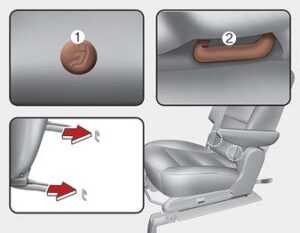
8 seats 2nd row
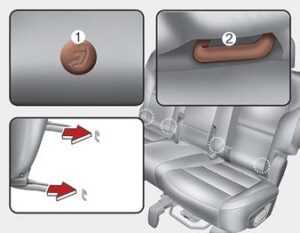
3rd row seat

- Lower Anchor position indicator
- Lower Anchor
The LATCH anchors are located between the seatback and the seat cushion of the left and right outboard of the 2nd row and the left outboard of 3rd-row seating positions.
Two LATCH anchors are also applied to the left of the 3rd-row seats.
Securing a child restraint with the LATCH anchors system
To install a LATCH-compatible child restraint in either of the rear outboard seating positions:
- Move the seat belt buckle away from the lower anchors. Otherwise, the webbing or buckle can be damaged by the latch anchor, which can make them become unusable or unsafe. (Especially 3rd row left outboard seating positions)
- Move any other objects away from the anchors that could prevent a secure connection between the child restraint and the lower anchors.
- Adjust the seat back to the full rearward position.
- Place child restraint on the vehicle seat, then attach the seat to the lower anchors according to the instructions provided by the child restraint manufacturer.
- If the child seat includes a top tether strap, attach the tether connector to the seat tether anchor according to the instructions provided by the child restraint manufacturer.
- Rotate the seat back forward to a locked position that ensures good contact between the seat back and child restraint.
- Then follow the child restraint instructions for properly adjusting and tightening the attachments on the child restraint to the LATCH anchors.
WARNING
Take the following precautions when using the LATCH system:
- Read and follow all installation instructions provided with your Child Restraint System.
- To prevent the child from reaching and taking hold of the unused seat belts, buckle all unused rear seat belts before the child is placed into the vehicle. Lock each unused seatbelt following the instructions in the “automatic locking mode” subsection, and place the webbing behind the child seat or against an unused seat-back. Children can be strangled if a shoulder belt becomes wrapped around their neck and the seat belt tightens.
- NEVER attach more than one child restraint to a single anchor. This could cause the anchor or attachment to come loose or break.
- Always have the LATCH system inspected by your authorized Kia dealer after an accident. An accident can damage the LATCH system and may not properly secure the child restraint.
NOTICE
The recommended maximum weight for the LATCH system is 65 lbs. (30 kg). When selecting a proper child restraint, consider that the maximum total weight of the child plus the child restraint should be less than 65 lbs. (30 kg).
As a guide, the MAX child restraint weight should be determined by the following calculation:
Child Restraint Weight = 65 – (child’s total weight in lbs.)
2023 Kia Telluride Specs, Price, Features and Mileage (Brochure)
Securing a child restraint seat with a “Tether Anchor” system
7 seats

8 seats
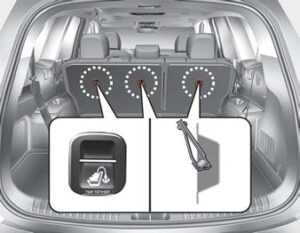
3rd row seat
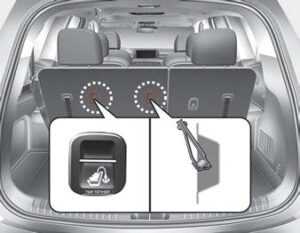
First secure the child restraint with the LATCH lower anchors or the seat belt. If the child restraint manufacturer recommends that the top tether strap be attached, attach and tighten the top tether strap to the top tether strap anchor.
Child restraint hook holders are located on the shelf behind the rear seats.
WARNING
Take the following precautions when installing the tether strap:
- Read and follow all installation instructions provided with your Child Restraint System.
- NEVER attach more than one child restraint to a single tether anchor. This could cause the anchor or attachment to come loose or break.
- Do not attach the tether strap to anything other than the correct tether anchor. It may not work properly if attached to something else.
- Do not use the tether anchors for adult seat belts or harnesses, or for attaching other items or equipment to the vehicle.
- Always fasten the seat belts behind the child restraint seat when they are not used to secure the child seat. Failure to do so may result in child strangulation.
To install the tether anchor:

- Route the child restraint tether strap over the child restraint seatback. Route the tether strap under the head restraint and between the head restraint posts, or route the tether strap over the top of the vehicle seatback. Make sure the strap is not twisted.
- Connect the tether strap hook to the tether anchor, then tighten the tether strap according to the child seat manufacturer’s instructions to firmly secure the child restraint to the seat.
- Check that the child restraint is securely attached to the seat by pushing and pulling the seat forward and from side-to-side.
Securing a child restraint with a lap/shoulder belt
When not using the LATCH system, all child restraints must be secured to a vehicle rear seat with the lap part of a lap/shoulder belt.
Automatic locking mode
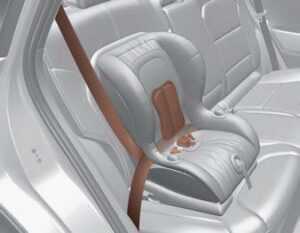
All passenger seat belts move freely under normal conditions and only lock under extreme or emergency conditions (emergency locking mode). So, in order to secure a child restraint, you must manually pull the seat belt all the way out to shift the retractor to the “automatic locking” mode.
The “automatic locking” mode will help prevent the normal movement of the child in the vehicle from causing the seat belt to loosen and compromise the CRS.
To install a CRS on the rear seats, do the following:
- Place the CRS on a rear seat and route the lap/shoulder belt around or through the child restraint, following the restraint manufacturer’s instructions.
Be sure the seat belt webbing is not twisted. - Fasten the lap/shoulder belt latch into the buckle. Listen for the distinct “click” sound.
Position the release button so that it is easy to access in case of an emergency.
- Pull the shoulder portion of the seat belt all the way out. When the shoulder portion of the seat belt is fully extended, it will shift the retractor to the “automatic locking” (child restraint) mode.

- Slowly allow the shoulder portion of the seat belt to retract and listen for an audible “clicking” or “ratcheting” sound. This indicates that the retractor is in the “automatic locking” mode. If no distinct sound is heard, repeat steps 3 and 4.

- Remove as much slack from the belt as possible by pushing down on the CRS while feeding the shoulder belt back into the retractor.
- Push and pull on the CRS to confirm that the seat belt is holding it firmly in place. If it is not, release the seat belt and repeat steps 2 through 6.
- Double-check that the retractor is in the “automatic locking” mode by attempting to pull more of the seat belt out of the retractor. If you cannot, the retractor is in the “automatic locking” mode.
NOTICE
When the seat belt is allowed to retract to its fully stowed position, the retractor will automatically switch from the “automatic locking” mode to the emergency lock mode for normal adult usage.
WARNING
Auto lock mode
Set the retractor to Automatic Lock mode when installing any Child Restraint System. If the retractor is not in automatic locking mode, the child restraint can move when your vehicle turns or stops suddenly. A child can be seriously injured or killed if the child restraint is not properly anchored in the car. To remove the child restraint, press the release button on the buckle and then pull the lap/shoulder belt out of the restraint and allow the seat belt to retract fully.
FAQ
A: A Child Restraint System (CRS) is a safety device designed to secure and protect infants and children in a vehicle.
A: Yes, the use of CRS is typically mandatory for child passengers to ensure their safety.
A: The Telluride typically accommodates various types of CRS, including rear-facing infant seats, convertible seats, and booster seats.
A: It’s crucial to follow the manufacturer’s instructions for both the CRS and the vehicle to ensure proper installation. The Telluride typically includes LATCH (Lower Anchors and Tethers for Children) anchors for securing CRS.
A: Yes, you can typically use the vehicle’s seat belts to secure a CRS if it’s not compatible with LATCH anchors.
A: Yes, there are usually guidelines provided by both the CRS manufacturer and the vehicle manufacturer for weight and height limits.
A: Some Telluride models may allow for the deactivation of the front passenger airbag when a rear-facing CRS is installed.
A: The safest seating position for a CRS is typically the rear seat, preferably the middle position, as it provides the most protection in the event of a collision.
A: Yes, the third-row seats in the Telluride are typically designed to accommodate CRS, but it’s essential to follow the vehicle and CRS manufacturer’s guidelines for proper installation.
A: Yes, the Telluride typically has top tether anchors that can be used to secure forward-facing CRS.
A: The vehicle and CRS manufacturer’s guidelines often include specific instructions for securing CRS during emergencies or collisions.
A: Yes, the Telluride typically allows for the installation of multiple CRS, but it’s essential to follow the guidelines and ensure proper spacing between seats.
A: Regularly inspect and adjust the CRS to ensure it remains securely installed and properly fitted as the child grows.
A: If you have any concerns or questions about CRS installation or use, consult the vehicle’s owner’s manual, CRS manufacturer’s instructions, or seek assistance from a certified Child Passenger Safety Technician.
A: The Telluride may include safety features such as seat belt reminders and airbag deactivation for the front passenger seat to enhance CRS safety.
Useful Link
View Full User Guide: Kia Telluride 2022 User Guide
Download Manuals: https://owners.kia.com/content/owners/en/manuals.html
2023 Kia Telluride Specs, Price, Features, Milage (brochure)

